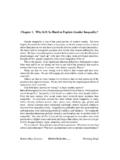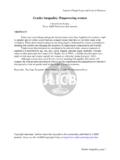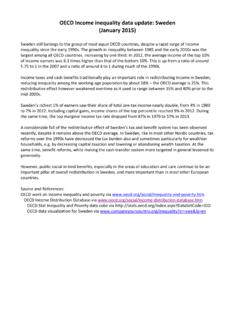Transcription of Chapter 1. What is Poverty and Why Measure it?
1 Poverty Manual, All, JH Revision of August 8, 2005 Page 8 of 218 Chapter 1. What is Poverty and Why Measure it? Summary Poverty is pronounced deprivation in well-being. The conventional view links well-being primarily to command over commodities, so the poor are those who do not have enough income or consumption to put them above some adequate minimum threshold. This view sees Poverty largely in monetary terms. Poverty may also be tied to a specific type of consumption; thus someone might be house poor or food poor or health poor. These dimensions of Poverty can often be measured directly, for instance by measuring malnutrition or literacy.
2 The broadest approach to well-being (and Poverty ) focuses on the capability of the individual to function in society. The poor lack key capabilities, and may have inadequate income or education, or be in poor health, or feel powerless, or lack political freedoms. There are four reasons to Measure Poverty . First, to keep the poor on the agenda; if Poverty were not measured, it would be easy to forget the poor. Second, one needs to be able to identify the poor if one is to be able to target interventions that aim to reduce or alleviate Poverty .
3 Third, to monitor and evaluate projects and policy interventions that are geared towards the poor. And finally, to evaluate the effectiveness of institutions whose goal is to help the poor. To help countries think clearly and systematically about how the position of the poor may be improved, and to act in consequence, the World Bank favors the Poverty Reduction Strategy Paper (PRSP) process. Countries are expected to Measure and analyze domestic Poverty , and to identify and operationalize actions to reduce Poverty . The PRSP process requires strong technical support.
4 A central purpose of this manual is to impart the technical and analytical skills needed for this purpose. Learning Objectives After completing the Chapter on What is Poverty and Why Measure It? you should be able to: 1. Define Poverty . 2. Summarize the three main views of Poverty . 3. State four justifications for measuring Poverty . 4. Summarize the role of the Poverty Reduction Strategy Paper (PRSP) process. 5. Explain why technical and analytical training in Poverty analysis is needed. Poverty Manual, All, JH Revision of August 8, 2005 Page 9 of 218 The concept of well-being and Poverty According to the World Bank (2000), Poverty is pronounced deprivation in well-being.
5 This of course begs the question of what is meant by well-being. One approach is to think of one s well-being as the command over commodities in general, so people are better off if they have a greater command over resources. In this view, the main focus is on whether households or individuals have enough resources to meet their needs. Typically Poverty is then measured by comparing an individual s income or consumption with some defined threshold below which they are considered to be poor. This is the most conventional view Poverty is seen largely in monetary terms and is the starting point for most analyses of Poverty .
6 A second approach to well-being (and hence Poverty ) is to ask whether people are able to obtain a specific type of consumption good: do they have enough food? Or shelter? Or health care? Or education? In this view the analyst would need to go beyond the more traditional monetary measures of Poverty : nutritional Poverty might be measured by examining whether children are stunted or wasted; and educational Poverty might be measured by asking whether someone is illiterate, or by the amount of formal schooling they have received. Perhaps the broadest approach to well-being (and Poverty ) is the one articulated by Amartya Sen (1987), who argues that well-being comes from a capability to function in society.
7 Thus Poverty arises when people lack key capabilities, and so have inadequate income or education, or poor health, or insecurity, or low self confidence, or a sense of powerlessness, or the absence of rights such as freedom of speech. Viewed in this way, Poverty is a multi-dimensional phenomenon, and less amenable to simple solutions. So, for instance, while higher average incomes will certainly help reduce Poverty , these may need to be accompanied by measures to empower the poor, or insure them against risks, or to address specific weaknesses (such as inadequate availability of schools or a corrupt health service).
8 Poverty is related to, but distinct from, inequality and vulnerability. Inequality focuses on the distribution of attributes, such as income or consumption, across the whole population. In the context of Poverty analysis, inequality requires examination if one believes that the welfare of an individual depends Poverty Manual, All, JH Revision of August 8, 2005 Page 10 of 218 on their economic position relative to others in society. Vulnerability is defined as the risk of falling into Poverty in the future, even if the person is not necessarily poor now; it is often associated with the effects of shocks such as a drought, a drop in farm prices, or a financial crisis.
9 Vulnerability is a key dimension of well-being since it affects individuals behavior (in terms of investment, production patterns, and coping strategies) and the perceptions of their own situations. The concepts, measures and analytical tools covered in this manual are mainly introduced in the context of the monetary measures of Poverty , especially consumption. However, they frequently are, and should be, applied to other the dimensions of Poverty . Why Measure Poverty ? It takes time, energy and money to Measure Poverty , since it can only be done properly by gathering survey data directly from households.
10 Why, then, do we need to go to the trouble of measuring Poverty ? At least four good reasons come to mind. To keep the poor on the agenda Perhaps the strongest justification is that provided by Ravallion (1998), who argues, "a credible Measure of Poverty can be a powerful instrument for focusing the attention of policy makers on the living conditions of the poor." Put another way, it is easy to ignore the poor if they are statistically invisible. The measurement of Poverty is thus necessary if it is to appear on the political and economic agenda.















